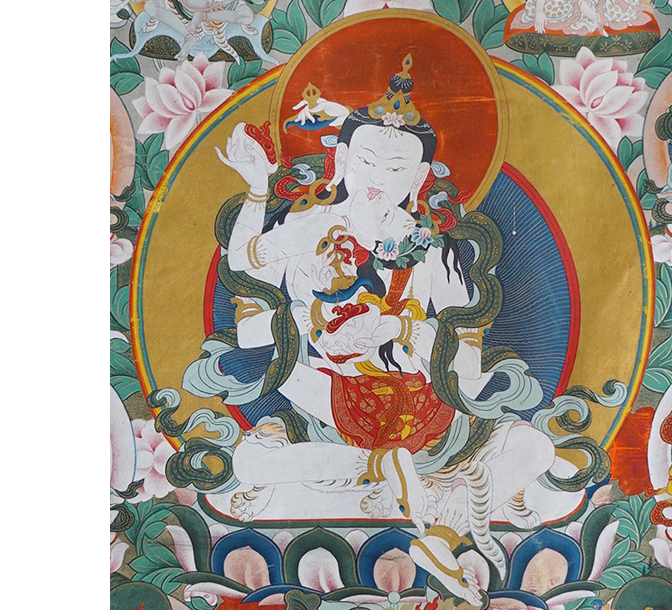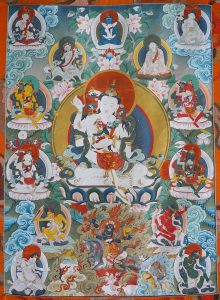Rigdzin Sogdrub
Published on June 18, 2024
Accomplishing the Life Force of the Vidyādharas of the Three Roots
Opening the Path of the Lotus Net: The Daily Practice Activity Sādhana and Secret Sādhana, Mother and Child, Combined Together
This treasure text received as a pure vision by Lhatsun Namkha Jigme, suited for both daily practice and larger ceremonies, is centered on Padmasambhava and his retinue. Compiled and annotated by Jamgön Kongtrul Lodrö Taye, this sādhana epitomizes the view and practice of Atiyoga by invoking Padma Tötreng Tsal and offering a profound teaching on the nature of reality as the luminous pure realm of Khecara.

In celebration of Dzongsar Khyentse Rinpoche’s birthday, Khyentse Vision Project has made available the new edition of Douglas Mills’ translation of the Rigdzin Sogdrub, Accomplishing the Life Force of the Vidyādharas of the Three Roots. This precious terma was revealed by Lhatsun Namkha Jigme, a previous incarnation of Jamyang Khyentse Wangpo and Rinpoche himself. The sādhana was arranged by Jamgön Kongtrul Lodrö Taye.
In 1646, Namkha Jigme left his native land of Tibet for Sikkim, following the advice of his teacher, to go and open the hidden lands prophesied by Guru Rinpoche as a safe haven for the Dharma during future times of strife. The journey was not without its difficulties. According to one legend, the local deity of the great Kangchenjunga mountain refused to let the stranger enter and buried him in a snowstorm. Exerting himself in the yoga of inner heat, Namkha Jigme was able to melt the snow and survive. Though the storm raged more fiercely, it was unable to cover the yogi’s head. The mountain god finally relented, but Namkha Jigme’s skin had turned blue, as he is depicted in tangkas and statues.
According to another tradition recorded by the king of Sikkim a century ago, Namkha Jigme and his followers were halted at the border by massive impassible cliffs. The yogi used his supernatural powers to fly up and over Kubra pass. He was importantly recognized by the god of Kangchenjunga, who appeared to him in the form of a white “vulture swan” and showed him how to proceed. Namkha Jigme was also welcomed by the king, the local lamas, and the people, to whom he would affectionately become known as “the madman from Kongpo” or, more widely, Lhatsun Chenpo (literally, “Great Lhatsun,” a title based on his royal family lineage from the Lha dynasty of southern Tibet). He was also recognized as an incarnation of both the Indian monk Vimalamitra and the omniscient Longchenpa. Proceeding to the area of Tashiding in western Sikkim, which he regarded as the heart of the mythic realm, he took up residence in a cave called Lhari Rinchen Nyingpuk. It was in retreat here—within a matrix of sacred space experienced as a luminous buddha field integrally linked with his own subtle body and inseparable from his awareness of emptiness and clarity—that he would have his pure vision of the Rigdzin Sogdrub.
The original draft translation, was undertaken by Douglas Mills under the guidance of Dzongsar Khyentse Rinpoche. Before Douglas passed away in 2023, he entrusted his translations to KVP and in particular requested KVP to review, edit and publish his translation of the Rigdzin Sogdrub. KVP carefully reviewed the translation against the Tibetan, checked with Dharma teachers and Himalayan experts on finer translation points, and updated the text according to the highest possible editorial standards. This process was meant to ensure that the translation could be a reliable and inspirational vehicle for awakening for present and future practitioners of this precious terma. Douglas had a deep connection with Sikkim, the heartland of Lhatsun Namkha Jigme’s revelations, and over the course of his life he made fourteen pilgrimages there to practice the Rigdzin Sogdrub. Read KVP’s tribute to Douglas Mills here.
Khyentse Vision Project dedicates this revised translation to Douglas.
Rinpoche recently gave the Rigdzin Sogdrub transmissions in Sydney, and KVP made it a priority to provide the practice material for those who received the empowerment. Since this sādhana is strictly intended for Rinpoche’s sangha who have received the empowerment, the direct link to the text is not to be shared with anyone.
To access the text, please click here.
We hope this new edition of the Rigdzin Sogdrub will benefit many beings and will provide a tendrel for Rinpoche’s long life and auspicious activity!

